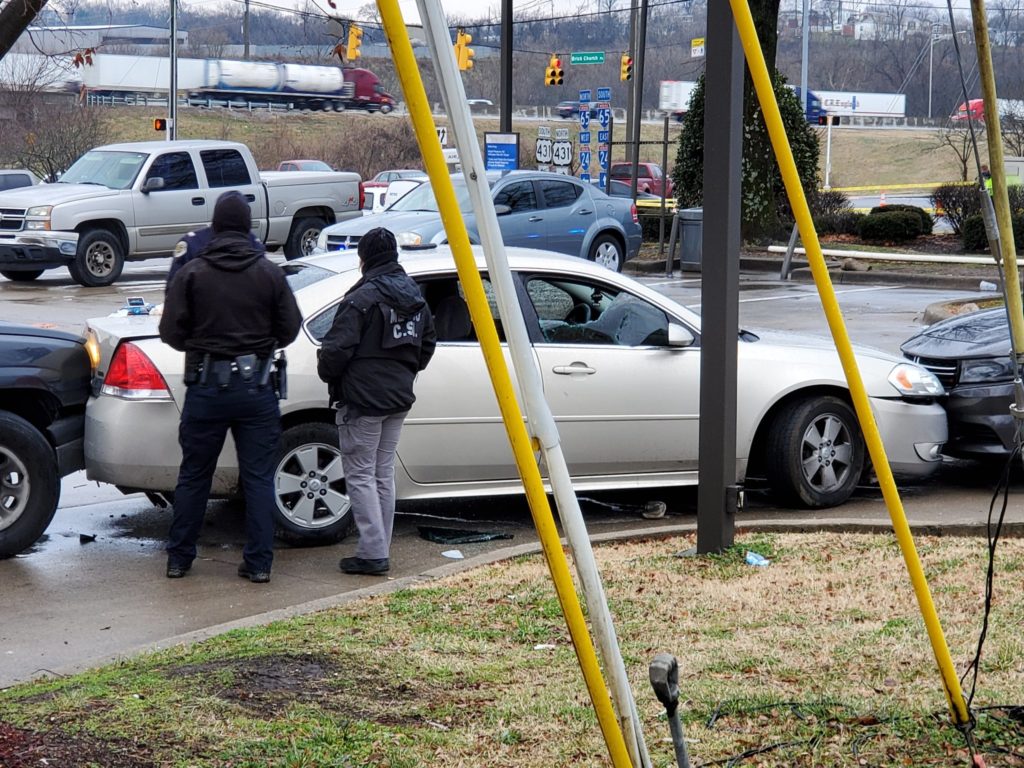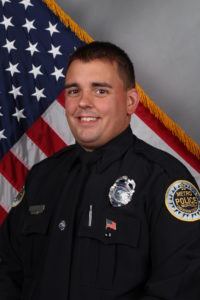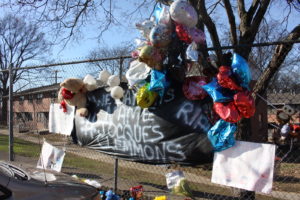
The Nashville police officer who shot and injured a man during an attempted arrest last month has a history of using force, police records show.
Officer Wesley McClelland had fired his gun twice before. He killed an armed home invasion suspect in 2016 and shot a dog several years earlier. The department determined those shootings followed department policy in both cases.
As authorities investigate the latest incident, records from his 9-year career portray a path within the Nashville police department that rewarded an officer for making arrests and that has not penalized his uses of force.
McClelland has reported using force 13 times since joining the department in 2012 — ranging from wrestling and pushing to Taser probes and gunfire. The department has never found that he violated policies when using force. He has been reprimanded for damaging his police vehicle, missing two court appearances and using profanity during a traffic stop, according to his disciplinary file.
McClelland’s department records reveal a pattern of proactive policing, sometimes in tandem with other MNPD officers who have also entered the spotlight for using force. The nearly 650 pages of records also shed light on the actions that have been rewarded within a department that has been pushed to rethink some of its tactics.
A history of force
After McClelland shot a robbery suspect Jan. 27, the police department was quick to acknowledge he had previously used deadly force.
 Courtesy Metro Nashville Police Department
Courtesy Metro Nashville Police Department Officer Wesley McClelland served for several years on the East Precinct flex team and was recently assigned to a new Community Field Intelligence Team.
In September of 2016, McClelland fatally shot Sandy Duke during a foot chase in northeast Nashville. Duke was suspected of breaking into a home in Robertson County and stealing two guns.
McClelland and a group of officers found Duke in a parking lot and chased him. McClelland later told investigators he saw the man pull a silver handgun and point it in the officer’s direction. McClelland fired four rounds.
While the department investigated the shooting, McClelland was commended for his “courageous action” that day.
The officer’s personnel file shows his supervisors nominated him for an award, writing that his “actions in the face of great danger to himself have made not only the citizens of Nashville safer, but his fellow officers as well.” McClelland then received an honorable recognition from then-Chief Steve Anderson, for his “selfless service in the face of a volatile situation,” and for rendering medical aid after shooting Duke.
Several months later, MNPD’s Use of Force Review Board voted unanimously to clear McClelland of any wrongdoing, citing a portion of the department manual that allows officers to use deadly force in self-defense.
That wasn’t the first time McClelland had used his gun. In November of 2013, a little over a year after graduating from the academy, the officer shot a pit bull in the face after a woman reported that it was attacking her kitten.
Records show that McClelland was about to call Animal Control when the dog charged at him. He fired twice.
Other incidents were less forceful: grabbing a woman’s wrist while breaking up a fight, tussling while trying to get someone handcuffed, and shoving a robbery suspect to the ground. McClelland also used his Taser during a foot chase.
WPLN News was unable to review four use of force reports. One was part of an ongoing criminal investigation and three involved juveniles.
Only 27% of police officers say they have ever pulled the trigger on duty, a 2016 Pew Research Center national survey found. Little federal data exists on police use of force, but the Bureau of Justice Statistics estimates that police used or threatened to use force against just 1.9% of people they interacted with in 2008.
Trouble from a traffic stop
The department has always found that McClelland was acting within its policy when using force. Besides reprimands for damaging his vehicle and missing court — which are common among MNPD employees — the officer has only been disciplined once for an interaction with a resident.
In that case, McClelland received a reprimand for cursing during a traffic stop near the Cayce Homes in East Nashville. It occurred at a time when Nashville police were conducting nearly eight times as many traffic stops as the national average and were often using those stops to search cars for evidence of a more serious crime.
McClelland wasn’t the only officer involved. And the narrative described in his disciplinary file shows how a routine traffic stop can escalate.
By the time the curse word had been uttered, McClelland and another officer had tried to force a man out of his car to search it, even though they later admitted they had no reason to believe he had committed a crime. When the man refused, they pulled him out against his will.
The officers never wrote the man a traffic ticket. Instead, they arrested him for assaulting an officer and resisting arrest, though those charges were eventually dropped.
The department determined that McClelland only broke policy when he told the man to “Let go of my [expletive] hand.” The other officer faced harsher discipline because he was the one who stopped the driver.
 Tony Gonzalez WPLN News
Tony Gonzalez WPLN NewsA memorial to Jocques Clemmons was created in February, 2017 after he was fatally shot by a Metro officer. File.
That officer was Joshua Lippert. A year and a half later, his record came under scrutiny when he shot and killed Jocques Clemmons after another traffic stop in the Cayce Homes. He resigned in 2019 but never faced internal discipline nor criminal charges.
When McClelland and Lippert tried to search the man’s car, they were on the lookout for crime. They were both serving on a flex team, tasked with riding through East Nashville to prevent criminal activity, instead of responding to 911 calls. (Chief John Drake recently disbanded those units and replaced them with neighborhood engagement units).
McClelland and Lippert’s supervisor questioned why the officers had tried to search the man’s car in the first place, instead of ending the traffic stop when they determined there were no warrants out for his arrest. A 2017 analysis found that Lippert searched five times as many cars as his colleagues.
“[H]e starts asking for consent and pulls the guy out of the vehicle after requesting consent, because he thinks that we can pull anyone out of a vehicle,” Sgt. Gene McCollum told investigators from MNPD’s Office of Professional Accountability. “That’s pretty much my biggest concern. The traffic stop had ended and here we are trying to pull someone out and put him on the ground.”
Under former Chief Anderson’s leadership, traffic stops served as a common tool for Nashville police to look for more serious violations, like illegal drug and gun possession. In a 2012 newsletter, Anderson called them “a major crime detection/prevention strategy” and said the department closely monitored the location of the stops to determine what “hot spots” officers ought to watch more closely.
McClelland said he thought a Supreme Court decision allowed police to search anyone’s car, even if they didn’t have probable cause. Sgt. McCollum later informed him that officers only have the right to ask for someone to step out of their car.
The department’s traffic stop training at the time instructed officers to ask for permission to search for drugs, money and weapons, urging them in a slideshow to “GET A YES ANSWER,” as shown below.
 Courtesy Metro Nashville Police Department
Courtesy Metro Nashville Police Department A traffic stops training written in 2015 instructs officers to ask for a consent search following a traffic stop.
MNPD has since rewritten its traffic stops training and reduced their use by more than 80%. But the changes only occurred after two separate reports found that stops rarely turned up criminal evidence and disproportionately affected people of color.
Lippert and McClelland were both punished for their handling of the traffic stop, though the department determined that they had not obstructed the driver’s rights. In the years since, Lippert, McClelland and McCollum have each shot someone on duty, and Lippert and McCollum have both resigned.
An MNPD spokesperson says McCollum didn’t often work with Lippert and McClelland. The police union did not respond to a request for comment on McClelland’s history with the department.
‘Beyond the routine call of duty’
McClelland’s records are lengthy, but not just from use of force and discipline. The officer’s file is also stacked with accolades — mostly for taking action.
He has been given commendations multiple times for seizing guns and drugs during traffic stops and for making arrests. He was even named police officer of the month in September 2016 and November 2017.
Chief Anderson thanked him for catching criminals 10 times.
 Courtesy Metro Nashville Police Department
Courtesy Metro Nashville Police Department Former Chief Steve Anderson praises McClelland for seizing contraband after a traffic stop in a letter of commendation in 2017.
“The achievement documented in this commendation served to remove an armed convicted felon from our streets, achieved the seizure of a loaded weapon and drugs, and safely accomplished from a traffic stop, and the probable prevention of further violent crimes by this dangerous criminal,” Anderson wrote in a 2017 letter to McClelland. “I am proud of your dedication that continues to extend far beyond the routine call of duty.”
These letters of praise are common for officers who serve on proactive units, which seek out crime in “hot spots” throughout the county. WPLN News frequently found such records in the personnel files of the members of the Juvenile Crime Task Force — which Drake has also disbanded — when investigating that team for the Deadly Force podcast.
They also send a message to officers about what metrics are valued within the department: arrests and contraband seizures.
That proactive behavior often earns praise from residents, especially when people are arrested without incident. But it sparks criticism when someone gets hurt or killed.
Since the recent shooting, McClelland has been reassigned to desk duty while the department and the Tennessee Bureau of Investigation review what happened. The man he shot is in jail on theft, aggravated robbery and assault charges.
Per policy, the police department will also review the “vehicle jam” technique that officers used in the arrest.
Samantha Max is a Report for America corps member.

